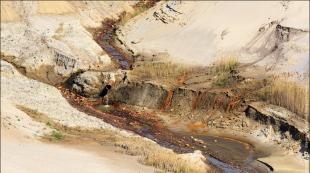Amber stone where can be found. Where amber is mined in Russia: amber deposits in Russia, types of deposits, places, methods and methods of stone extraction. Is it possible for individuals to mine in Russia
We went to the city of Yantarny. The only amber mining plant in the world is located here. Moreover, 90% of the explored world reserves of amber are located here.
Approximately 50 million years ago, a significant warming of the climate occurred on Earth and, as a result, abundant resin flow of trees in the coniferous forests of Scandinavia. The resin was oxidized by atmospheric oxygen and accumulated in the soil of the "amber forests". Rivers and streams gradually washed out hardened clods of resin from the ground and carried them to the mouth of a large river that flowed into the ancient sea on the territory of the modern Kaliningrad Peninsula.
Thus, the largest amber deposit in the world, Primorskoye, or Palmnikenskoye, was formed. It has no equal, not only in terms of proven reserves, but also in terms of the concentration of the gem. Here, amber is found in the so-called blue earth - a sandy-clay rock of marine origin, widespread on the territory of the Kaliningrad Peninsula.
Since ancient times, in the Baltic, amber has been collected on the beaches and shallows, where it was thrown out by the sea, and used for medicinal, religious, and artistic and applied purposes. Over the past three millennia, about 60 thousand tons of the mineral have been collected on the coast of the Baltic Sea. Since the 16th century, a new way of extracting amber has become widespread on the beaches - fishing. Catchers, armed with large nets, on 6-8-meter poles entered the water or went out to sea in boats and caught algae with amber entangled in them.
For the first time, amber was mined by land method in the middle of the 16th century. Pits were dug on the shore, and if amber grains were found in the soil, the bottom was loosened further until groundwater appeared. Pieces of amber floated to the surface. In the middle of the 17th century, attempts were made to dig up amber from coastal cliffs. And already in 1871, the first mine was laid with a depth of about 30 meters for the industrial extraction of amber near today's village of Sinyavino.
More productive was the extraction with the help of open mine workings in the first half of the 19th century. Small quarries (30 x 30 meters) were laid on the coastal areas richer in amber. Layers of waste rock were torn off and a layer of "blue earth" was opened, which was developed. But by the beginning of the 20th century, underground mining had become unprofitable. And in 1912, at a distance from the sea, for the open development of the deposit, a large quarry was laid, which was operated for about 60 years and exhausted itself only in the early 70s.
Before World War II, about 400 tons of raw amber per year were mined at the Palmnikenskoye deposit: about half of them were processed at the Königsberg amber manufactory, which included several factories and workshops in various places in East Prussia. In the late 1930s, more than 2.5 thousand workers and employees were employed at the amber enterprises of Palmniken and Koenigsberg. The same number of workers, mostly women, were hired for auxiliary work in the winter.
When in 1945 the Russian liberator troops came to the lands of East Prussia, everything showed that the Germans had stopped mining amber even before they arrived. The amber quarry was flooded and looked like a large yellow dead lake.
The mining enterprise, which operated under the Germans, was decided to be reanimated. Several tens of tons of first-class amber remained in the warehouses of Palmniken after the retreat of the German troops. Thanks to these stocks, small workshops were organized in which demobilized Soviet soldiers and German residents who remained in the village worked.
Later, the workshops were transformed into the Amber Factory at the military trade, which produced beads, bracelets, mouthpieces and souvenirs from amber, insulators for geological instruments for the exploration of uranium and radium ores. This is how the first post-war products of the amber plant appeared.
In 1947, the Amber Factory was visited by a government commission headed by A.N. Kosygin, who came to the conclusion that it was necessary to transfer it to the jurisdiction of the Ministry of Internal Affairs, which has qualified personnel and experience in organizing work in the extractive industries. On July 21, 1947, the Council of Ministers of the USSR adopted Decree No. 2599 on the transfer of amber production, together with the quarry, to the system of the USSR Ministry of Internal Affairs. The new enterprise was given the name "Combine No. 9".
The formation of the plant did not entail the liquidation of the Amber Plant of the Russian Gems Trust. The plant was relocated to the village of Primorye near Svetlogorsk and housed in the building of the Yakor camp site. In fact, it was one workshop, which at the beginning of the 50s employed no more than 120 people. The plant received raw materials from plant No. 9, the range of products remained not very rich.
In the autumn of 1947, the pumping of water from the quarry into the sea began, the rock was removed from the bottom, and the sites were restored. At the same time, the access roads were reconstructed and the surviving equipment was repaired. In June 1948, the quarry was put into commercial operation, and by the end of the year, 115,897 kg of raw amber had been mined.
In 1953, the Amber Plant was transferred from the system of the Ministry of Internal Affairs to the Russian Gems trust, at the same time the plant and the plant were merged. The new management of the plant was formed from specialists sent from Leningrad, headed by the first civilian director K.P. Polyakov, who was soon replaced by K.N. Rizaev.
For the efficient operation of the enterprise, it was necessary, first of all, to resume the industrial production of amber. The stable operation of the quarry was hampered by the lack of equipment and spare parts, and the lack of qualified specialists. The situation began to improve after V.N. Rozhkov, an experienced mining engineer. But the possibilities of the career laid down at the beginning of the century were largely exhausted. The areas with the highest amber content were thoroughly developed, and the most promising southern part of the deposit remained practically inaccessible for mining due to frequent soil landslides.
The process of extraction and purification of amber at that time was significantly different from how it happens today. During the first decade after the start-up of the plant, the quarry was developed only by excavation. The overburden rocks were sent to the dump along the railway line, and the “blue earth” containing amber was delivered by electric trains for primary processing. The results of the quarry in the 50s were not high enough. On average, 240 tons of amber were mined per year, and its fine fractions prevailed, while the demand for the Baltic gem continued to grow.
It was necessary to make a radical update of the entire production technology. The impetus for the beginning of the reconstruction was given by the elements of nature. On November 7, 1957 and February 10, 1958, one after the other, two catastrophes occurred - large soil landslides, as a result of which more than half a million tons of earth fell to the bottom of the quarry. Almost the entire transport system was disabled, all equipment was covered up. The landslides occurred over the weekend, when there were no workers in the quarry, thus avoiding tragedies.
The consequences of the natural disaster turned out to be so significant that it became impossible to carry out mining operations according to the previous technological scheme. In this regard, since 1958, the transfer of overburden operations to the principle of hydromechanization began. With the help of a powerful hydraulic monitor, the top layer of waste rocks (it reached 38 meters in the old quarry) collapsed and turned into pulp, which was pumped into the sea by a dredger. A relatively thin layer of waste rock, one and a half to two meters, covering the blue earth, was removed with a multi-bucket excavator, then the amber-bearing earth was delivered to the processing plant by electric trains or through a pipeline.
In 1960, the government decided to build a new quarry with a capacity of 1000 tons of amber per year on the basis of the Primorskoye deposit, located two or three kilometers east of the Yantarny village, which was put into operation only in 1976. But the new quarry did not justify the hopes associated with it.
Mistakes were made during the design, not all geological conditions were taken into account. Due to the high content of stones in the developed rocks, the dredgers provided for by the project turned out to be unsuitable. After the new quarry was put into operation, it produced about 100 tons of amber per year. I had to continue working at the old quarry, despite its official closure in 1972. The lack of raw materials for all the main productions of the plant was associated with the deterioration of the quality of the amber-bearing rock.
The share of the most valuable large amber continued to decrease. In these difficult conditions, the management of the plant decided to start work on the seashore at the Beach site, located along the seashore between the villages of Sinyavino and Yantarny and which is an integral part of the Palmnikenskoye field. Hydromonitors eroded the rock and, along the slurry pipeline, it was thrown onto the seashore. Thus, more than 500 meters were washed up.
Here another quarry was laid. Already in 1972, 450 tons of amber were mined there. The advantage of the Beach area was that the cost of amber mined here is 3 times lower than in the new quarry due to the small depth of occurrence - only 10-12 meters from the surface (in the new quarry, the "blue earth" layer is at a depth of 50 -60 meters).
The same new quarry put into operation in 1976.

The quarry was immediately dug to a depth of 50-60 meters and further work is being carried out on alluvial amber already at the bottom of the quarry. The worker controls a hydraulic monitor (water jet, in a simple way), which gives out a stream of water under a pressure of 6 atmospheres and washes away the top layer of waste rock, which is then pumped into the sea by a dredger. 
Then a thin layer of waste rock covering the blue earth is removed by a walking dragline. 
And the amber-bearing earth is delivered by pipeline to the processing plant for further processing. 
And this is an old German quarry. Now flooded. It has crystal clear water, and Moscow oligarchs are building cottages on the far bank. 
Mine Anna. It was discovered by the Germans in 1871. It worked until 1924. Here in 1945 there was a mass execution of 7,000 Jews. 
Now let's move on to the manufacturing plant. There is very strict control over the work team. After all, just a few years ago, tons were stolen from the plant. And the employees of the plant were last interested in wages.
Now there is an active fight against it. Several people guard the operator of the hydromonitor at the production site, and there is also double control at the checkpoint of the plant. The amount of stolen amber at the plant is such that in Gdansk (Poland), which is considered the world capital of amber, it will last for ten years ahead without additional purchases from the plant.
Here, the incoming stones from the factory are washed again. 
The raw stones are then sorted. 
Fraction size. 
The larger the stone, the more expensive it is. 
Stone cutting department. 
Here is the cutting... 
... and grinding stones. 
The whole process is done by hand. 
Then the polished stones are sorted again. 
And they go to assembly. 
Where beads and other jewelry are collected. 


And there is also a workshop where artists sit and with the help of a dental drill, figurines are made from the largest amber stones. 
Painstaking manual work. 
You can also visit the museum. By the way, in August last year, the plant began to develop a tourist direction. An observation deck at the plant's quarry was opened for free access, premises are being prepared for a museum, a shop and an exposition of the plant's history. So far, the museum is located on the territory of the plant, but at the same time it has a very extensive collection of exhibits. 

Types of amber. 

Particularly large stones. 
The largest specimens are stored separately, have their own number and set value. This stone weighing 2.4 kg costs only 3600 dollars. 
Various figurines. 
And the shell of a mollusk found last year, which, according to scientists, is 300 million years old. 
In general, the tourist direction is developing very actively in Yantarny now, the entire tourist infrastructure is ready, many cultural and sporting events are planned for the summer. And in view of the fact that there is a full-fledged sandy beach in Yantarny, it is even better to spend the summer season here than in Svetlogorsk. But all this in the next part.
On a regional basis, the following groups of amber are best known:
1. Baltic (includes: Russian, Polish, German (Saxon), Danish, Swedish)
2. Ukrainian
3. Dominican
Let's take a closer look at these deposits.
Russia
The largest amber deposit in the world is located here. It is located on the Baltic coast of the Kaliningrad (Sambian) peninsula in the vicinity of the village of Yantarny. According to expert estimates, about 90% of the world's amber reserves with an age of about 50 million years are concentrated here.
The field is divided into 3 sections: Palmnikensky, Primorsky (mining since 1976), Plyazhevy (produced 500-600 tons of raw materials per year, operated from 1972-2003). Geological exploration has identified new potential areas for development, the total reserve of which is approximately 300,000 tons. The potential of the Palmnikensky and Primorsky quarry is estimated at about 116,000 tons (if we take a production of 500 tons per year, then the deposit can produce amber for more than 200 years).
The extraction of amber is carried out by an open pit method. The area of the quarry is almost 1,500,000 sq. meters. The amber-bearing layer (blue earth) of glauconite sand lies at a depth of 40-60 m (sometimes up to 100 m).
On average, 1 cubic meter of blue earth "gives away" 500-600 g of amber, sometimes there are accumulations of up to 4,500 g per cubic meter. The size of the pieces varies from a few millimeters to 15-20 centimeters. There are exclusive specimens up to 30-40 cm. Most of the mined Russian amber is succinite (98%), 2% is gedanite (wax-yellow amber). Unique amber samples weighing more than 500 g are not so common.
Annual production is several tens of kilograms. Fractions, the weight of which is equal to or exceeds 1 kg, are equated to precious ones. The volume of annual production ranges from 300-350 tons.
Ukraine

In Ukraine, in the Rivne region, there is another well-known amber deposit. Quarries are scattered in a kind of triangle - near the villages of Sarny, Klesovo and Dubrovitsy.
Amber lies close to the surface of the earth (3-10 meters), and therefore its extraction is much cheaper than in the Kaliningrad region. But this has little effect on the market price, since raw material is mined in small quantities.
1 cubic meter of earth contains approximately 250 g of amber, sometimes the accumulation can reach 1000 g. The average size of fractions is 1-10 cm, less often up to 15 cm. Sometimes pieces weighing more than 1 kg are found. expert estimates are approximately 1,500 tons.
Germany

In the east of Germany, in Saxony-Anhalt, there is a deposit of "Saxon amber", whose age is estimated at about 22 million years. A coal quarry was once laid near the city of Bitterfeld, and a little later, amber deposits were discovered here, the only ones in these lands.
According to its properties, Saxon succinite is similar to Kaliningrad. An important difference is the crust fractions. Pieces of amber may or may not have an oxidation crust. Plant or animal inclusions are identical to inclusions in Kaliningrad amber.
In recent years, before the flooding, on average, amber production was about 28 tons per year. During the period from 1975 to 1990, the land gave away more than 400 tons of amber. In 1998, the mining site was decided to be reclaimed (reclamation - land restoration). Quarry flooded. The process lasted 4 years. Potential amber reserves are estimated at about 1000 tons. In the meantime, the quarry, which has become an amber lake, accepts tourists.
Dominican Republic

The next well-known amber deposit is located on the island of Hispaniola (Haiti - the local name), which is divided between the Dominican Republic and the Republic of Haiti. Active mining of raw materials is carried out only in the Dominican Republic.
The age of mountain amber is 15-40 million years, and it is mined in the Cordillera at an altitude of 500-1200 meters. These are rather hard-to-reach places, so mining is carried out by small artels of miners, 5-10 people each.
Most often, there is no full development of mines, which can reach a depth of up to 100 meters. The lack of qualified miners and difficult working conditions interfere. The color palette of mountain amber: blue, green, cognac, red-yellow. Almost all mined pieces are transparent, very often there are inclusions of ancient flora or fauna. Dominican amber is second in importance after the Baltic amber.
Full or partial copying is possible with the permission of the site and the obligatory placement of an active link.
Amber is a fossil resin of ancient coniferous plantations. Over time, the resinous formations have petrified, become hard enough to withstand external destruction, many of them have grown into sedimentary rocks and are found as inclusions in stones. Amber is known to man as long as people themselves exist on Earth. It is found at archaeological excavations of the settlements of primitive people.
Magical significance was attached to this light and beautiful pebble, different tribes considered it to be pieces of the Sun that had fallen to the ground, they treated ailments with it, bewitched it with the help of jewelry, and made conspiracies against it. All this exists to some extent now, but the main purpose of this organic material is industry, medicine, electronics, and jewelry.
Ancient ways of extracting amber
 Extraction of amber by the “scooping” method
Extraction of amber by the “scooping” method Usually people collected pieces of resin on the seashore. Sea waves often carried them to the beaches, small fragments were found in large numbers on the coasts of the whole world. But over time, there were more and more hunters for amber fragments and people had to fish them out of the water on a boat. Such a fishery was called "scooping", since they caught resin formations with nets. To get to larger pieces, "gouging" was used. This was done with the help of pointed peaks in shallow water. And when the deposits at a shallow depth dried up, it was time for the "wells" - diggings, which were located on the beach area. In the 16th century, the first shallow quarries appeared and the extraction of stone became industrial.
Modern technologies of amber extraction
Currently, the development of amber is carried out in large quantities, large companies are engaged in this and use mechanized mining methods, this work has several stages.
Development by hydromonitor and dredgers
 Hydromonitor blurs the top layer
Hydromonitor blurs the top layer This method is the main one and represents the impact of a powerful water jet on the overburden (a coating that covers the amber-bearing layer).
Water, together with the waste rock, forms a pulp, which is discharged into the sea through pipes with the help of suction dredgers.
The exposed "blue earth" is being developed by a walking excavator. With the help of a ladle, this mass, rich in amber contents, is folded into cone slides and the hydromonitor starts working again, turning this slide into a mud-like slurry.
 Amber mining - walking excavator
Amber mining - walking excavator Dredgers this slurry through the pipe system to the processing plant. Through these manufacturing steps, the precious raw material is subject to wastage - 10 percent of the material is wasted in this process.
Experts believe that the best production option is a method that excludes hydrotransportation. Technically, this is done like this: a bucket-wheel excavator selects the “blue earth” in the quarry and feeds it to the conveyor. According to it, all rock with amber content goes to the processing plant, where amber inclusions are extracted without loss.
The final stage of extraction is the sorting of fragments by size, color, content of inclusions, transparency, configuration.
Why can amber be colored?
Resin fossilized in sedimentary rocks can take on the color of surrounding minerals. Therefore, amber is not only yellow and golden, it can have different shades - green, brown, blue and even white. According to the refraction of light, the pebbles are divided into transparent, opaque, smoky.
The main places of extraction of amber
The main places of extraction of amber are the Baltic states, the Kaliningrad region, Western Ukraine, the Urals. There are deposits in Mexico, Japan, China, Romania and Sicily. But the main area of occurrence of large deposits is the coast of the Baltic Sea. These stones are exported, their quality is valued all over the world. The remaining deposits are of no commercial importance.
If you find an error, please highlight a piece of text and click Ctrl+Enter.
What do you associate the Kaliningrad region with? Baltic Sea, Curonian Spit and… amber. We have 90% of the world's reserves of this stone and the world's largest deposit. As part of the mega-project of the Community of St. Petersburg bloggers and HeadHunter, we visited the Amber Plant to see the process of amber mining with our own eyes.
Let's start with a brief excursion into the history of amber and its mining. Baltic amber is the hardened resin of trees that grew in the vast territory of the southern part of the Scandinavian Peninsula and adjacent areas within the borders of the modern Baltic Sea. Approximately 45-50 million years ago, there was a significant warming and humidification of the climate, which caused an abundant release of resin from trees. In the air, it oxidized, covered with a thick dark brown crust, and in this form accumulated in the soil. Rivers and streams gradually washed out hardened clods of resin from the earth and carried them to the mouth of a large river that flowed into the ancient sea. This is how the world's largest amber deposit, Palmniken, was formed.

The oldest and most primitive way of extraction is manual collection on the beaches and shallows, where the sea threw amber. It was this method that was the main one in ancient and medieval eras. Now it is used only by tourists who often walk along the beaches and carefully peer into the sand.

Since the 14th century, another method of extraction has become widespread - catching with large nets. After storms, the sea often raises algae with amber from the bottom. People went into the water and pulled nets to their shore. This method is still popular with modern amber divers, who can often be found after storms on the shores of the Baltic Sea. Sometimes they find really large pieces.

Since the middle of the 17th century, attempts began to dig up amber from the coastal cliffs, and in 1871 the first amber mine was laid in the area of the present village of Sinyavino. Its depth reached 30 meters. The mine was closed after seven years due to unprofitability and danger of work. In 1872, Shtantin & Becker acquired the Palmniken estate, rented the right to mine amber there, and began to develop production. Several mines were laid on the beaches, and the Anna mine, which operated right up to 1925, became the most productive.

More productive was the extraction with the help of open mine workings, which began in the first half of the 19th century. On the coast, small quarries 30 by 30 meters were laid, layers of waste rock were torn off, revealing the "blue earth". In 1912, at the Palmnikenskoye deposit, a large open pit 50 meters deep was laid - "Walter", which was exploited for about 60 years. In those days, the work was done by bucket-wheel excavators that scooped up the “blue earth” and loaded it into open cars of an electric train that followed to the processing plant. Before World War II, about 400 tons of raw amber per year were mined at this deposit. It was processed at the Koenigsberg Amber Manufactory and other enterprises of East Prussia.

After the war, the Germans destroyed almost all the equipment that was used to extract amber. But already in 1947, on the basis of the Palmnikensky deposit, the Kaliningrad amber plant was created. The old German quarry "Walter" was reconstructed by Soviet engineers and German specialists. "Voluntary-compulsory." When the possibilities of this quarry were exhausted, in 1976 a new Primorsky quarry was built. To date, this is the only place on Earth where 90% of the world's amber reserves are concentrated.

The seaside quarry makes an impression. The average depth of the amber layer is 50 meters, which means that it still needs to be reached. At the same time, the thickness of the "blue earth" varies from 0.5 to 17.5 meters, an average of 7.5 meters.


I’ll tell you right away about the protection of the quarry. Even on an official tour, no one has the right to pick up even a small piece of amber from the ground. All participants in the mining process are searched several times at the exit from the quarry. It is said that even governors and ministers obey these rules. Such security measures are not surprising, since there are a lot of so-called "black diggers" in the Kaliningrad region. They are tearing up the beaches and fields near Yantarny and even trying to get through to official quarries. It is said that such a risk is worth the possible consequences, since the price of large pieces of amber on the black roar can be very decent.

The most effective way of extracting amber is open, using the principle of hydromechanization. This brings us to truly unique professions that are now difficult to find in any other region of Russia. One of them is the operator of the ESH-10 walking excavator. There are four such machines in the quarry and they are able to move on special pontoon legs. Considering the size and weight of the excavator and the condition of the land on which it stands, this is perhaps the only way to move.

At one time, the bucket of an almost 700-ton machine can scoop up about 20 tons of rock.

After that, the "blue earth" falls under a jet of water under high pressure and is washed away. The water itself comes from the Baltic Sea and, passing through all the pipes and filters of the Amber Combine, it returns there. Without any harm to the environment.

The second unique profession is an amber miner. At the moment, this is the easiest and most effective way to catch large pieces of amber. The work is hard and even harmful, but it cannot be automated. Any attempt to exclude a person from this process has so far been a failure.

And so people in overalls stand and from the blurred blue clay they catch especially valuable large ambers with nets.


The remaining slurry is sent through a pipeline to a processing plant located at the plant. At the factory, the “blue earth” washed out by water passes through a grate with holes with a diameter of 5 cm, where workers select the largest pieces of the mineral, then through a sieve with holes of 2 mm, through which most of the waste rock dissolved in water goes to waste.

The remaining material is passed through a system of arc sieves, where it is initially washed and dehydrated. Then in the separator, in a special solution with a density higher than that of amber, the mass is stratified, heavy particles settle to the bottom, small amber with pieces of wood floats to the surface. Then repeated washing and drying in calorific ovens. Basically separated from impurities, amber is delivered to a screen - a system of sieves located one above the other and moving in opposite directions with holes of different diameters.

But the Amber Combine is famous not only for its production. Its subsidiary, Yantarny Yuvelirprom, is engaged in the production of various products: from simple costume jewelry to real works of art. According to statistics hh.ru Amber crafters, stone carvers and jewelers-fitters are in great demand in the region. At the same time, the average salary of such specialists for the first quarter of 2017 reached 42.5 rubles. An experienced specialist can earn much more.

Amber is first sorted by quality, color and volume. Depending on these parameters, his fate is decided. The extracted stone is divided into ornamental, pressing and varnish. Then it is sawn, cut, drilled, polished and sent to jewelers. See photos.



Until recently, the only deposit of amber on the planet was considered to be well-known to many Baltic. However, about 200 more places of occurrence of this solar stone have recently been discovered and studied. Most of them are within Europe. But there are such deposits also in Asia, South and North America, Australia.
Where to find amber in Russia
In Russia, as well as in general throughout the world, the main deposit of solar stone is still Baltiyskoye. It is located near the village of Yantarny on the Baltic Sea. Hundreds of tons of amber are mined here every year. However, in Russia there are also small deposits of this stone in the Urals and Sakhalin. A very large field - Kolesovo-Dubrovitskoye - was discovered not so long ago in Ukraine.
To find out more precisely where to find amber, you should first of all study the layout of its deposits on the map. Sunstone deposits are located on Earth in the form of a grid of straight and broken lines. Below is the "amber" grid for Central Europe.
The richest amber-bearing vein runs on this map, as you can see, from the Yutlad peninsula through the Kaliningrad region and Finland. Further, it stretches towards the Kola Peninsula, and then passes through the Arctic Ocean towards the "Amber Crown" of the planet.
Can private individuals mine gems in Russia?
Free diligence in our country, unfortunately, is prohibited by law. You can search for gems and gold, but only after concluding an agreement with some large mining company. Although the authorities, for example, in some regions of the Urals periodically promise to allow free mining of gems by ordinary people, such a law has not yet been adopted at the moment (2017). Therefore, the information below is provided to the reader for informational purposes only. Of course, it is not worth engaging in black diligence before the adoption of the relevant law. This can result in a large fine or even criminal liability. In Ukraine, prospecting is also prohibited by law.
Features of offshore production
The simplest answer to the question of where to find amber is, of course, the Baltic Sea. In this region, the extraction of solar stone, in principle, can be carried out even simply using nets. In particular, there are many stones on the coast and shallow water appears during small storms. During this period, the water throws out a lot of solar pebbles. Silt and debris are picked up with a net. Further, they are simply viewed for the presence of amber. In this way, you can get quite a lot of stones, including quite large ones. Most of the amber in the Baltic was once found in those places where a lot of black mud was nailed by the sea.
Sometimes amber on the Baltic Sea after a storm can be found right on the shore - in the sand. Too much sun stone in this way, of course, you will not get. But with a certain amount of patience, it will still be possible to find several small ambers (and possibly large ones).
Mining on water pipes
This method of searching for amber is used mainly in Ukraine. Water pipes (mines) are located in this country along the banks of rivers. Finding them is quite difficult. But the thing is still quite doable. There are water pipes, by the way, not only in Ukraine, but also in many other places on the planet. In Russia, they can also be searched along the banks of rivers. By the way, in water pipes you can find not only amber, but also other gems and even diamonds. Such mini-mines can be hollows on the shore flooded with water, stone "rivers", etc. Experienced prospectors also determine the pipes by color (usually it is darker or lighter than the main rock). Such mines can be located both on the shore and directly in the water. In Ukraine, natural amber lies in them at a depth of about 5 meters. The companion of the sun stone in this country is always blue or blue clay.

Amber in the forest and near the river
Unfortunately, there is no reliable information about the finds of amber in the forests of Russia. However, it is known for sure that in the Zhytomyr region prospectors find amber right in the coniferous forests. In this case, their helpers are often, oddly enough, moles. Digging out passages, these animals "carry out" to the surface, including blue clay. And she, as already mentioned, is a constant companion of amber. Seeing blue clay in a molehill, prospectors simply dig a few meters deep in this place.
How to find amber in the forest, we found out. But sometimes this stone can be found just on the surface of the earth along the banks of rivers. In this case, it is better to search in the spring after a flood or after a heavy rain. At this time, the water washes out of the ground a lot of the stones in it, among which it may be. It is also believed that the best time to search is early spring. During this period, there is still no vegetation on the banks. And consequently, the stones are more visible.

The easiest way to find amber on the river bank is with the help of an ultraviolet flashlight. Such a device today can be purchased at almost any kiosk. Under ultraviolet rays, amber, unlike other stones, begins to glow with a very beautiful blue light. You can also distinguish sunstone from other minerals by weight. The stone is actually very light. By weight, it resembles, for example, the same rosin.









